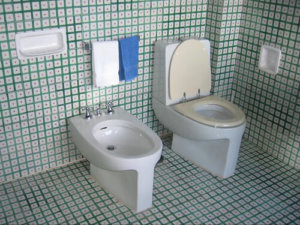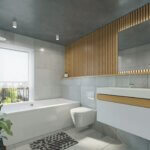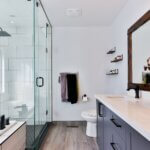Just Get One Already: Why You Need a Bidet
If you’ve ever traveled internationally, you’ve likely made a surprising discovery when using the restroom. Bidets, also known as washlets, are standard fixtures in bathrooms throughout Asia and Europe. However, Americans have never gotten on board with the concept of having them in our home bathrooms or public restrooms. Discover the advantages of installing a bidet in your bathroom and learn more about its purpose.
What Is a Bidet?

Image via Flickr by mandydale
A bidet is a bathtub-like washtub with faucets or taps mounted on the unit. To use a bidet, you first fill the basin with water and straddle the bidet to wash below the belt. You’ll usually find bidets next to toilets in bathrooms and restrooms when you travel abroad.
A Brief History of the Bidet
The bidet concept first came into being during the 1600s in France. The bidet complemented the chamber pot in bedrooms and dressing chambers. Writing for The Atlantic, Maria Teresa Hart explains that early designs for bidets resembled ornamental ottomans. The basins were concealed within wood furniture frames with short legs. Leather, wood, or wicker covered the lids to help them blend in with surrounding pieces of furniture.
During the early part of its history, the bidet’s use became associated with the aristocracy and high society. That’s because carrying water into the house in large quantities was a highly laborious process, and bidets were considered a luxury among individuals within these social classes. With the advent of indoor plumbing during the 1800s, the bidet moved from the bedroom to the bathroom. As awareness of the bathroom apparatus spread, citizens of France, Western Europe, Latin America, the Middle East, and Asia became active users of the bidet in their bathrooms and lavatories.
According to Hart, bidets never caught on in the United States despite their appeal in other countries around the world. In 1964, Arnold Cohen, founder of the American Bidet Company, created a bidet design that combined a toilet seat with a spritzing function. While he struggled to market his creation to the American audience, Cohen met with representatives from a Japanese trading company called Nichimen Jitsugyo. The firm eventually created a proprietary model, followed by another Japanese company, Toto, which introduced a tech-centric washlet around 1980. To use the company’s multifunctional bidet-toilet hybrid, individuals could activate the device by using an automated control panel.
In an article published in the Taipei Times, Toto’s general manager of restroom product research, Hiroshi Kobayashi, commented on his company’s innovation. “We did what others were reluctant to try,” he said. “We brought electronics into the water closet.”
Bidet Advantages
Aside from personal hygiene advantages, bidets have several environmental and health benefits.
Environmental Benefits
While various sources debate how much toilet paper Americans use in a week or a year, you can’t ignore Americans’ toilet paper usage and its impacts on the environment. The World Wildlife Fund estimates that every ton of toilet paper produced requires about 1.75 tons of raw fiber. Since 2010, demand for the product continues to rise exponentially, the organization notes.
Eco-conscious advocates for bidets argue that increased bidet usage could have a twofold impact on both water and forest conservation. Bidets could conserve the amount of water and the number of trees needed to make toilet paper, as well as the gallons of water that Americans use to clean up through showering.
Health Benefits
Some people with specific medical conditions may benefit from the use of bidets in the home. For example, individuals suffering from hemorrhoids or inflammatory bowel disease may experience discomfort or pain when using toilet paper. Alternatively, a bidet can provide a gentle, soothing stream of water for cleaning up after using the bathroom.
Pregnant women and older adults who have reduced mobility could also benefit from using a bidet. A bidet eliminates the rotating, straining, and twisting motions performed when using toilet paper.
Types of Bidets

Image via Unsplash by reneeverberne
If you’re thinking about installing a bidet or washlet in your bathroom, familiarize yourself with some of the options you can purchase that don’t require a full bathroom remodel to accommodate them. Several types of smart toilets offer integrated bidet functions. Additionally, handheld attachments available on the market can enable you to add on bidet features to an existing toilet.
Smart Toilets With Integrated Bidets
Some of today’s toilet innovations incorporate a bidet function within their design. For example, Toto’s Washlet G400 comes with a high-tech electronic bidet seat, an automatic open and close feature for the lid, and remote-controlled front and rear warm water washing with adjustable temperature and water pressure control.
Bidet Seats
A simple to install bidet seat can transform any toilet into a sophisticated toilet and bidet combination. Toto’s Washlet Round S300e, for example, offers a heated seat with temperature control, a dual-action water spray with oscillating and pulsating features, and an automatic air deodorizer to improve the air quality in the bathroom.
Bidet Attachments
Bidet attachments are external devices that mount to the underside of an existing toilet seat. You install them by connecting the bidet attachment to the fresh water supply line for the toilet. Many models feature variable cleaning modes and options for controlling the water pressure and spray output.
Handheld Bidets
If your bathroom configuration doesn’t offer you the space for a permanent bidet installation, you can think about a handheld bidet attachment. This type of bidet resembles a handheld showerhead. If you’re considering this type of bidet, be sure your toilet has an external water supply that can support this device.
If you’ve been debating whether you should get a bidet for your bathroom, we hope that this article clears up any doubts you may have had. If you still have questions or need more information about bidets that we didn’t present in this piece, contact us at Allied Plumbing & Heating Supply Co. For over 30 years, we’ve helped do-it-yourself consumers by providing advice and offering name-brand plumbing products at low prices. Call us at 773-777-2670. If you live in or near the Chicago area, you can visit us at 6949 W. Irving Park Road in Chicago.



